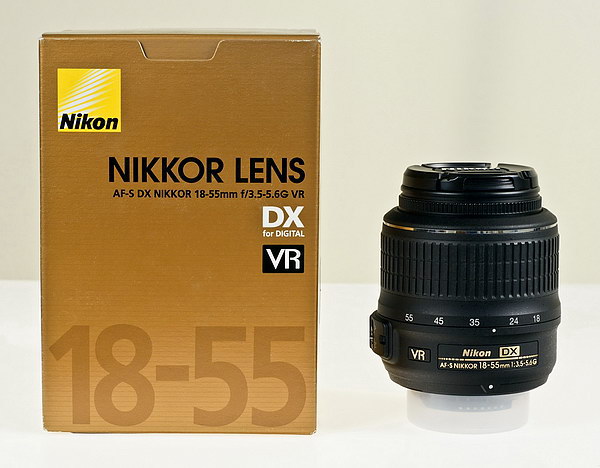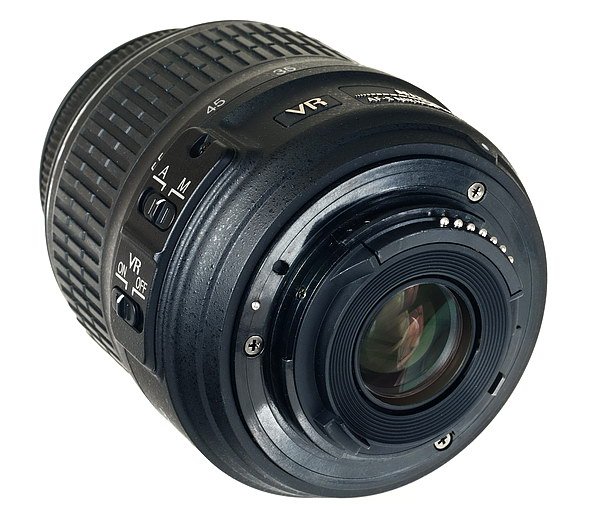Here’s a brief look at the Nikon AF-S DX NIKKOR 18-55mm F/3.5-5.6G VR zoom lens. Scroll down for the review.
|
Lens
|
Nikon AF-S DX NIKKOR 18-55mm F/3.5-5.6G VR zoom lens
|
|
Box contents
|
Front and rear caps, and a users manual.
|
|
Cost
|
$199 retail by itself, or $100 as part of kit.
|
|
Build quality
|
Good
|
|
Additional information
|
Basic kit lens with select camera bodies.
|
| Specifications below |
|
|
Optical configuration
|
11 elements in 8 groups
|
|
Angle of view
|
76°-28°
|
|
Aperture
|
7 blades, circular
|
|
Full frame and APS-C
|
APS-C only, 35mm equivalent, 27-82.5mm using 1.5x crop factor
|
|
Depth of field and focus scales?
|
Nothing
|
|
Minimum focus, image plane to subject
|
11″ (280mm)
|
|
Minimum focus, end of lens barrel to subject
|
4.9″ (124mm)
|
|
Hard stop at infinity focus?
|
No |
|
Length changes when focusing?
|
Yes
|
|
Focus ring turns in AF?
|
Yes, lens barrel itself
|
|
Filter size
|
52mm
|
|
Filter ring rotates?
|
Yes, lens barrel itself
|
|
Distance encoder?
|
Yes, Nikon type
|
|
Max magnification
|
0.31x
|
|
Min. F/stop
|
F/22-36
|
|
Sony teleconverter compatible?
|
N/A
|
|
Length changes when zooming?
|
Yes
|
|
Dimensions W x L (my measurements)
|
3.0″ x 3.15″ 77mm x 80mm, widest at buttons
|
|
Maximum extended length (my measurements)
|
3.8″ (96mm) at 55mm
|
|
Weight bare (my scale)
|
9.3oz (263g) 9.9oz (280g) with caps
|
Requisite product shots.
 |
| Box and contents |
 |
| Front element |
 |
| Rear shot, plastic mount |
 |
| Side shot fully extended |
 |
| Barrel switches |
The 6.1mp Nikon D40 was used for this review.
This is the basic “kit” wide zoom lens available for your Nikon APS-C sensor camera, and isn’t designed to be used on full frame/film cameras. There have been three distinct changes to the design of this lens, the first was just an 18-55mm G ED, the second ended with a “II,” the newest one is designated by a “VR” which means “vibration reduction, Nikon’s term for image stabilization. It’s rated for three stops improvement at 55mm. It has a AF/MF button and a VR on/off button on the side of the barrel. It’s made in Thailand, the same as the D40 camera. It has a silver ring near the end of the zoom ring, just like Canon-that’s weird. Nikon says they use one “hybrid” asperical element in the construction of the lens, but no “ED” element, like they listed for the “ED II.” Fit and finish are good, and seems better built than other “kit” lenses, even the “II” version of this lens.
Zoom control is smooth and even, the barrel runs in and out at different lengths like most cheap kit lenses, and is fully drawn in around 30mm. It extends out a maximum of .6″ (16mm) at 55mm. The focal length numbers are checked at; 18mm, 24mm, 35mm, 45mm, and 55mm.
Auto-focusing is accurate and quick. I notice when half pressing the shutter button with VR turned on, you hear a click, which indicates VR is engaging, and another click a couple of seconds later after you let up on the shutter button, meaning VR is disengaging. Vibration reduction only works when you half press the shutter button, after pressing and releasing, it turns off, it doesn’t just stay on when the camera is powered on. On this lens, you can actually hear the VR working, the Canon “IS” isn’t audibly noticeable. You also get a shift in the viewfinder image as VR goes on and off, this isn’t a problem, it’s normal operation. Manually focusing is so-so, you have a short 1/8 turn from close-in to infinity, so the slightest rotational movement can change the focus point. This lens focuses in reverse of the Canon and Sony, the Nikon goes out while turning the focus ring to the left. The closest focusing distance from lens barrel to subject is about 4.9″ or 124mm, the same as the Canon 18-55mm kit lens.
Aperture/focal length guide for the Nikon 18-55mm F/3.5-5.6G VR. This lens has overlapping numbers, which is common. It also uses 1/6 stop increments, not so common.
|
Maximum aperture
|
F/3.5
|
F/3.8
|
F/4
|
F/4.2
|
F/4.5
|
F/4.8
|
F/5
|
F/5.3
|
F/5.6
|
|
Range
|
18mm
|
18mm – 20mm
|
20mm – 22mm
|
24mm – 26mm
|
26mm – 28mm
|
29mm – 32mm
|
32mm – 34mm
|
35mm – 46mm
|
48mm – 55mm
|
Flare and ghosting. Overall good control, but there always seems to be a small orange color blob in the image near wide angle if the sun is close, similar to Canon’s kit lens tested here. See shot below. Use your hand to block it. The lens doesn’t come with a hood, and will cost $19 (retail) if you decide you want it. Based on experience, the little kit lens hoods do nothing. Save your money, your hand is free.
This lens is multi-coated and has the regular green/magenta look of most modern lenses.
Filter size. 52mm.
Coma. Moderate at 18mm from F/3.5-4.5, nearly gone at F/5.6, 24mm moderate to F/5.6, no problems elsewhere.
Color. N/A.
Lateral color fringing. Average control, most notable at wide angle where you’ll see magenta/green. Stopping down doesn’t help with this kind of color fringing. See small sample crop below.
 |
| Light to moderate pincushion distortion at 55mm. |
Barrel and pincushion distortion. The distortion at 18mm is moderate to strong. It disappears rapidly, and by 22mm-24mm, it’s flat. From then on pincushion starts, and results in light to moderate distortion at 55mm. See pictures above. The barrel distortion generated by this lens is easier to fix than most other lenses, because this distortion is bowed evenly along the image, not bowing primarily in the middle then flattening out, like the two other kit lenses reviewed.
Lens Bokeh. So-so to fairly smooth, about equal throughout the range.
light fall-off, directly below. Mild at 18mm and F/3.5, stopping down helps out, but there isn’t a problem even wide open. At the long end there is next to nothing. You can’t see this stuff in real pictures. Very good control here for a wide-zoom kit lens and indicative of other kit lenses tested.
|
18mm @ F/3.5
|
18mm @ F/5.6
|
 |
 |
Examples of ghosting and color fringing below.
|
18mm @ F/3.5 ghosting
|
18mm @ F/5.6 color fringing crop
|
 |
 |
The left shot above shows a small blob (lower left center) that appears when the sun is close to the image. The control here is about average for this type of lens. The right shot is lateral color fringing, cropped from the edge of the image. This kind of color fringing doesn’t get better by closing the aperture down. It’s not bad, and is about the same as other kit lenses.
Corner samples.
18mm corners below.
|
18mm @ F/3.5
|
18mm @ F/8
|
 |
 |
55mm corners.
|
55mm @ F/5.6
|
55mm @ F/8
|
 |
 |
The 18mm corners on the Nikon 18-55mm F/3.5-5.6 VR lens are pretty sharp. At wide angle, things look good at F/3.5. There’s a bump in sharpness at F/8 only. The 55mm corners are as sharp as the centers, even at F/5.6. The exposure differences are from light fall-off wide open at each length.
Center samples next.
18mm centers
|
18mm @ F/3.5
|
18mm @ F/4.5
|
 |
 |
55mm centers.
|
55mm @ F/5.6
|
55mm @ F/8
|
 |
 |
The wide end is sharp at F/3.5, and seems no sharper stopped down. The long end responds slightly to stopping down, though barely noticeable even when viewed at 100%.
Check out the close focus shot.
Below, check out the sample (291kb) and click to see a 100% cropped portion of the full image. The sample shot was taken with the 6.1mp Nikon D40. The subject is a standard US stamp, 1″x 3/4″ or 25.4mm x 19mm. Also, note the macro shot was taken as close to the subject as focusing allowed; In this case a short 4.9″ or 124mm, measured from the front of the lens barrel to the subject. Compare this macro with other Nikon and Canon lens reviews only. Do not compare with Sony mount lenses, as they were taken with the 12.2mp Sony A700.
Below, check out the sample (291kb) and click to see a 100% cropped portion of the full image. The sample shot was taken with the 6.1mp Nikon D40. The subject is a standard US stamp, 1″x 3/4″ or 25.4mm x 19mm. Also, note the macro shot was taken as close to the subject as focusing allowed; In this case a short 4.9″ or 124mm, measured from the front of the lens barrel to the subject. Compare this macro with other Nikon and Canon lens reviews only. Do not compare with Sony mount lenses, as they were taken with the 12.2mp Sony A700.
This lens has a large reproduction size at 0.31x, and produced a very sharp image at F/8, but not quite as sharp as the previous version of this lens, the ED II.
Conclusion.
The Nikon AF-S DX NIKKOR 18-55mm F/3.5-5.6G VR lens turned in a great performance, and quite similar to the Canon 18-55mm kit lens. There’s nothing bad to say about it. Excellent characteristics include; sharp across the image no matter what the focal length or aperture, build quality and focusing accuracy. Average items include; light fall-off, distortion, color fringing and flare/ghosting. The vibration reduction seems to work well, but I was never able to get three stops improvement, though my hands are pretty steady anyways. Your results may vary.
I had the older ED “II” model on hand, which performed about the same, except for the following; the VR macro shot is not as sharp as the ED II, flare and ghosting control are not quite as good either, light fall-off is better controlled on the VR, but none of these things are noticeable upon casual inspection, and a normal photographer wouldn’t worry about this stuff because it isn’t important to a good picture.
Value. This lens is very good, but do you need VR? The answer is probably no. The focal lengths covered in this lens aren’t really optimal for getting the most from vibration reduction, the only time you’ll need it is when your shutter speeds are less than 1/30sec at 18mm, and maybe 1/60sec at 55mm. In fact, if your camera dial is set to AUTO mode, you’ll never need the VR since the camera will boost ISO sensitivity automatically to increase shutter speeds in low light. When using VR, I notice about a two stop advantage at 55mm, that’s just me. Your results may vary. If you’re a jittery hands person, get VR, if you’re the average snapshot artist who shoots in good light, save some money (about $60) and get the ED “II” version.

